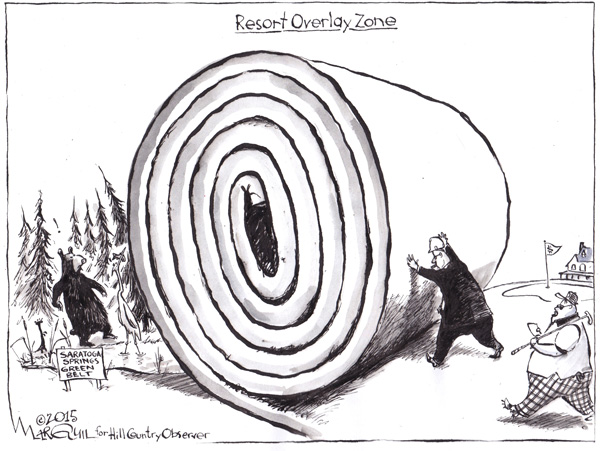Editorial April 2015
E D I T O R I A L
Changing the ground rules for Spa City development

We live in an era when zoning and planning laws supposedly give communities the power to shape their own destinies, where the public has a chance to shape the ground rules for their town’s development and an ability to scrutinize the specifics of each new project.
The reality in many communities, however, is a planning process that mainly serves the interests of, and is easily manipulated by, developers and the politically well connected.
Members of local planning boards sometimes seem to have surprisingly few powers. They must struggle to show, lest they be challenged in court, that they’re treating applicants even-handedly and not overstepping the authority of local laws that may be weak or poorly written. And they can spend huge amounts of time wrestling with opaque, technical terms that distract from what ought to be their focus: how a proposed development will actually look and function.
The result too often is towns that have voluminous planning guidelines but appear anything but well planned – or, worse, where cookie-cutter zoning laws actually require development patterns that are aesthetically and functionally dreadful.
Against this backdrop, the development of Saratoga Springs over the past two decades or so has been a bright spot in our region. The city has gotten its ground rules right, and it has used its planning process to focus development in its urban core and to protect green space around its outer edges – with dramatic results. The many new mixed-use buildings that have sprung up in its center since the 1990s have made downtown Saratoga a model for other cities across the Northeast.
It helps, of course, that the city has more than a few residents who care passionately about its history and character -- and aren’t afraid to speak out.
But as our cover story this month details, some fear the ground rules that have led to the city’s recent successes could be in jeopardy. Saratoga Springs is in the process of revising its comprehensive plan, and some local business leaders are pushing to ease restrictions on development in the city’s outer greenbelt.
The current controversy revolves around a proposal by Saratoga National Golf Club to expand into a year-round resort by adding a 100-room hotel, 96 condominiums and a health-and-fitness club to its property in the greenbelt area just east of Exit 14 of the Northway. The project, which would increase Saratoga National’s footprint from 10 acres to 27 acres of its 405-acre property, is not permissible under the city’s current rules.
The golf course has suggested that if the city doesn’t cooperate, it might carve up a chunk of its property into housing lots, which would be allowed under current rules. If the city goes along with its plans, however, the golf club says it would give up development rights on some 378 acres, keeping them forever green. (Much of this land might be unsuitable for development anyway.)
The Saratoga Springs City Council, which will wind up having to settle the whole issue in the next few months, should recognize the housing vs. resort choice for the red herring that it is, and instead focus on the real issue: Should the city loosen the rules in its outer conservation district in an attempt to benefit this single project?
A golf resort may not seem hopelessly incompatible with the notion of the greenbelt as a zone for recreation, but the city should be rightfully concerned about the precedent it would be setting for the next hotel developer who wants to build on the city’s outskirts.

